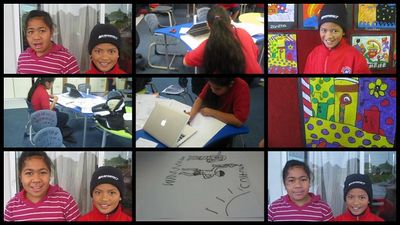Minimally invasive education/The Adapted Granny Cloud
Contents
[hide]MIE - The Adapted Granny Cloud
Mitra also discusses the notion of the "granny cloud" where Grandmothers from the UK use video chatting software (such as google video chat and skype) to read to children in India Mitra and the Granny Cloud.
My Australian colleague and I wondered if we could revise this approach using students teaching each other. We discovered that this had significant effects on both groups oral language and camera presentation skills. Children gave each other written feedback via their classroom blogs. Interestingly we noticed that the feedback they were giving each other were skills that they had to work on themselves (looking at the camera, speaking clearly, keeping still and so on). As time went on, the two groups created a shared understanding of what a classroom news show should look like without explicitly saying so.
Here is a video showing around 6 months of progressprogress vid. A lot more has happened since then. For example, the kids now share video footage so that they can use each other as guest reporters in their reports (again a mainstream media influence at play).
Using lights, cameras and action -
The creation of a TV News show. Interestingly the students have come up with a format organically. They have obviously been highly influenced by the mainstream media. The format goes News----> Sports ----> Weather.
The beauty of running this as an afterschool club means that I have the freedom to be completely Minimally Invasive. However time constraints have meant that I have put my finger in the pie, when it comes to editing.
For examples of this work see [1]
Just recently the students have started moving away from their set format. Instead of the standard news, sport, weather regular features have emerged such as Chocolate Vanilla Swirl, Word on the Street and even the weather seems to have taken a life of its own on. This has evolved over a year. Here you can see the Archive of BMPS After-School News Crew
Letting go of the editing
This term two authentic opportunities have arisen where I have had the opportunity to be even more minimally invasive.
School is cool competition
- Replicating an RSA animate!

The brief the children were given was: The minister of education thinks that you should be solely judged on Reading, Writing, and Maths - how can you convince her otherwise?
Students have also had discussions re creative commons licensing - they are fine with people learning, remixing, and have waived the non commercial clause. They would prefer that people who gain commercially are poor and not rich...
The Finger
One of our students badly damaged her finger in a door at school. This provided an authentic opportunity to create something special for the injured student. It was the last week of term so the students had the opportunity do some intensive MIE movie making. Note the soundtrack levels going up and down. I asked them how they did it. They looked at me sympathetically and said, "uh, ducking..."The point I am trying to make here is not so much about the content of the film, but that the skills that the students have acquired in movie editing have been achieved with minimal instruction. They have used trial and error to learn basic editing skills. They found Ducking through curiosity - they liked the sound of it so they applied it to see what it did. Then when they had an opportunity to use it - they remembered where it was and how it worked. It is also important to mention that this discovery took place in a group of 3-4 students. It was the conversation of "what's that for?" "I dunno try it..." "What did it do?" that enabled this real learning to take place. when they got better than me
From Oral Language to Written Language
- Is Technology Culturally Neutral?
In addition to this, we have had some MIE success using the adapted Granny cloud by way of Google Docs and WallWisher. The children in Geelong were learning about culture. My class has an extremely rich cultural mix (NZ Maori, Cook Island Maori, Tongan, Samoan, and Nuiean). We did not formally teach our children how to use the google doc. Instead we spent time talking about the more deeper issues (appropriate online behaviour etc) and then let them go for it. The children first discussed the usual themes (food, religion, clothes, jewellery etc).
Then for some reason one of my students very briefly referred to a Cook Island legend. The children from Geelong asked a couple of questions about it. The student couldn't remember all of the details from the story, but other children from the Cook Islands could remember parts of it. They looked for it on the Internet but found nothing (with the exception of a performed dance of the legend at a polyfest festival).
This brings up an interesting point that Puti Gardiner makes (she uses Te Reo Maori as an example). Is digital technology culturally neutral?
Her children came across the same phenomena when they googled Maori Technology the results that they received were of traditional fishing tools, waka, and weaving and there was very little information on Maori and the use of contemporary technology. After discussing this with her kids they decided to start making digital stories, films, blogging and wikiing, therefore contributing their contemporary stories to the digital world. It seems that in this digital age, it is essential that a digital footprint is created so that language, stories, and culture can be sustained.
Why is it not so easy to find my student's stories on the web, when finding European stories (contemporary and Traditional) is so easy? Who is responsible for rectifying this? Can I encourage my students to contribute their stories and narratives while maintaining their integrity? Is this okay?
My kids talked about how their stories are shared orally to them. This is often through their Grandparents and that is how stories are passed on throughout their culture. There are, of course, variations to each story depending on whose Grandparents version we listen to. The story that was referred to, for example, had many variations within my classroom where debates raged about whether or not the main character wore the skin of a goat and so on.
The use of a shared google doc was brilliant for this phenomenon. The flexibility and collaborative nature of it allows multiple perspectives to come through. When my children come back to school with the varied versions of the same story from their Grandmas, we were be able to see these differing points of view and piece together common themes.
The children were able to record and share their versions of the story with their Australian friends who were then able to draw their own conclusions (given that they had observed the drafting and sharing process).
This example also highlights how our role as teachers are changing. Even for the areas such as reading and writing. I am no longer selecting writing topics and providing stationery. I am working 24/7 to provide authentic and interactive audiences. Studying cultures is not confined to generalist books but providing learners with opportunities to collaborate with other learners from around the world.
